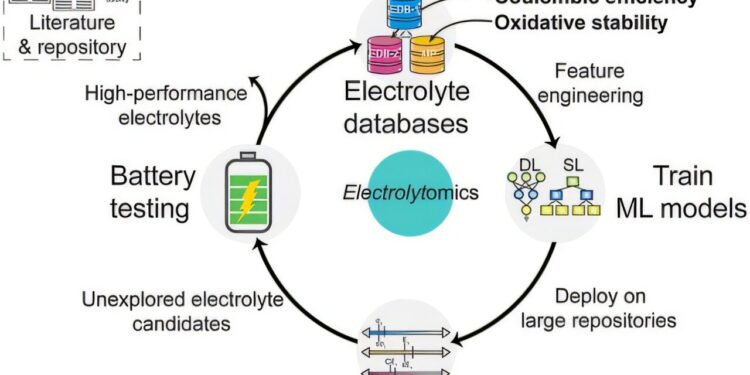Credit: Material chemistry (2025). DOI: 10.1021 / ACS.CHAMMATER. 4C03196
Discovering new powerful electrolytes is one of the main bottlenecks in the design of new generation batteries for electric vehicles, phones, laptops and energy storage on the network.
The most stable electrolytes are not always the most conductive. The most effective batteries are not always the most stable. And so on.
“Electrodes must satisfy very different properties at the same time. They are still conflict with each other,” said Ritsh Kumar, a scholarship holder Eric and Wendy Schimdt in postdoctoral science working in the Amanchukwu laboratory of the University of Chicago Pritzker School of Molecular Engineering (Uchicago PME).
Kumar is the first author of a new article published in Material chemistry This puts artificial intelligence and automatic learning at work. The paper describes a new frame to find molecules that maximize three components that make an ideal battery electrolyte – Ionic conductivity, oxidative stability and Coulomb efficiency.
Drawing from a set of data compiled from 250 research articles dating back to the first days of research on lithium-ion batteries, the group used AI to compensate for what they call “escration” for different molecules. Escore balances these three criteria, identifying molecules that check the three boxes.
“The champion molecule on a property is not the champion molecule in another,” said Kumar’s principal investigator, Uchicago PME Neubauer, assistant family professor in molecular genius Chibueze Amanchukwu.
They have already tested their process, using AI to identify a molecule that works as well as the best electrolytes on the market, a major advance in a field which is often based on tests and errors.
“Optimization of electrolyte is a slow and difficult process where researchers frequently use tests and error to balance competing properties in multi-component mixtures,” said Jeffrey Lopez, assistant professor of Northwestern University, in chemical and biological engineering, which was not involved in research. “These types of data -oriented research frames are essential to help accelerate the development of new battery materials and take advantage of progress in the sciences and laboratory automation compatible with AI.”
Batteries’ music
Artificial intelligence takes place promising candidates so that scientists test in the laboratory so that they waste less time, energy and resources on dead ends and false departures. Uchicago SME researchers are already using AI to help develop cancer treatments, immunotherapy, water treatment methods, quantum materials and other new technologies.
Since the theoretical number of molecules that could make battery electrolytes is 1060Or one with 60 zeros after that, a technology that can report likely billions of non-starters gives researchers a huge advantage.
“It would have been impossible for us to go through hundreds of millions of compounds to say:” Oh, I think we should study this one “,” said Amanchukwu.
Amanchukwu compared the use of AI in research to listen to music online.
Imagine an AI formed on the musical taste of a particular person, the combination of qualities that enter their own personal escopon for good songs. The new electrolyte research has created the equivalent of an AI that can go through an existing reading list and a song from Song, predict if the person will like it. The next step will be an AI that can create a song reading list that he thinks that the person will like, a subtle but important conceptual adjustment.
The last step – and the objective of research on the AMANCHUKWU laboratory – will be an AI that can write music, or in this case design a new molecule, which responds to all the parameters given.
A graphic design oddity
The team began organizing AI training data manually from 2020.
“The current data set has thousands of potential electrolytes that we have extracted from the literature that lasted more than 50 years of research,” said Kumar.
One of the reasons why they must manually enter the data does not come from chemistry, but from graphic design.
When the researchers write articles and magazines have them in magazine format, the figures that the team transform into an esclore are generally in the images. It is the illustrations, graphics, diagrams and other JPEG or .png graphics that work in the text, but are not part of the text itself.
Most large -scale language models with research articles have just read the text, which means that the Uchicago PME team will manually enter the training data for a while.
“Even the models today really find it difficult to extract images,” said Amanchukwu.
Although the training data is massive, this is only the first step.
“I don’t want to find a molecule that was already in my training data,” said Amanchukwu. “I want to look for molecules in very different chemical spaces. So we have tested how these models predict when they see a molecule that they have never seen before.”
The team noted that when a molecule was chemically similar to that of training data, AI predicted how good electrolyte precision with great precision. He had a hard time reporting unknown materials, marking the team’s next challenge in the quest to use AI to design new generation batteries.
More information:
Ritesh Kumar et al, Electrolytomics: a unified approach to Big Data for the design and discovery of electrolytes, Material chemistry (2025). DOI: 10.1021 / ACS.CHAMMATER. 4C03196
Provided by the University of Chicago
Quote: An approach from Big Data for new generation battery electrolytes (2025, May 5) recovered on May 5, 2025 from
This document is subject to copyright. In addition to any fair program for private or research purposes, no part can be reproduced without written authorization. The content is provided only for information purposes.



